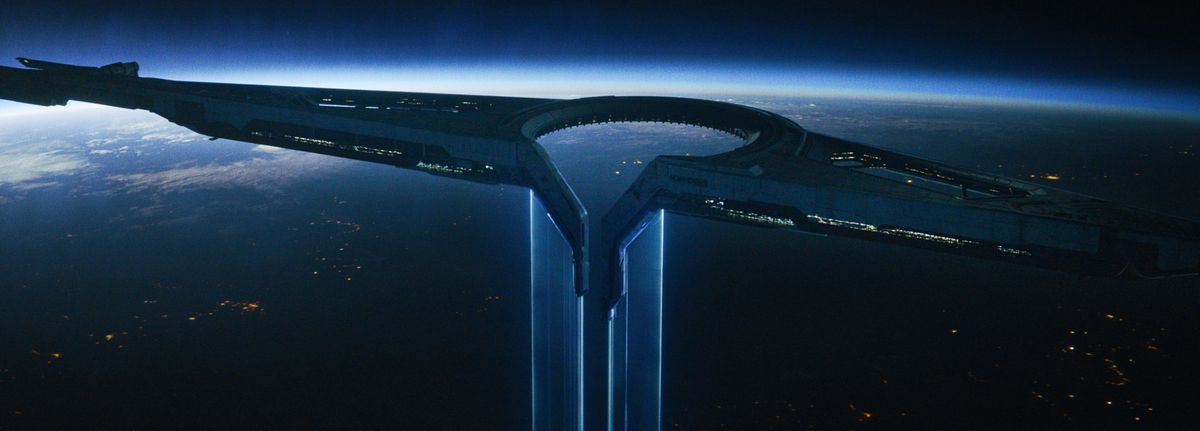The United States’ officially designated “Global War on Terrorism” began 22 years ago, just three days after the Sept. 11 attacks. The U.S. ostensibly launched that war to combat terrorism, and went on to wage it in at least four different countries, which were often falsely homogenized into “the Middle East” to simplify the government’s messaging. President George W. Bush’s rhetoric at the time insisted that the war on terror was about eliminating terrorist threats to America’s security, freedom, and way of life — though in truth, the word “threat” was applied loosely, and “guilty by proximity” replaced “guilty by association.” The war ultimately lasted 20 years and functionally ended, after a protracted semi-occupation of Afghanistan by U.S. forces, with an unceremonious retreat in 2021 — though low-level combat operations continue to this day in other regions.
The Creator, the excellent new science fiction movie from director Gareth Edwards (Rogue One: A Star Wars Story) is not about the war on terror. But it is about the world that the war on terror left in its wake.
The script, by Edwards and Chris Weitz, sets the story in a slightly alternate history. In the near future, robots called Simulants (or Sims) are loaded with artificial personalities and intelligence that mimics humankind. After a tragic attack by a rogue Sim, the result of a human programming error, the U.S. government decrees that Sims are a threat to Americans’ freedom and way of life, and must be eradicated. So the U.S. Army goes to a region called “New Asia” — a collection of a Southeast Asian countries that allow Sims to have rights on par with those of humans — with NOMAD, a new weapon that’s essentially a suborbital flying fortress. NOMAD can rapidly move anywhere in the region and bomb areas suspected of Sim activity, which strikes fear into the locals and makes underground Sim operation difficult, but certainly not impossible.

When America began its war on terror, few could have accurately predicted a decadeslong quasi-occupation of a foreign country. And it wasn’t until years later that information about the collateral damage of U.S. airstrikes started to gain traction in the public eye and on the world stage. Political and military officials have often described drones as weapons with “surgical” precision, but as it turns out, explosions aren’t choosy about who they kill.
The Creator puts all those acts — the death and destruction wrought by warfare and military occupation — front and center. In the movie’s universe, NOMAD is a flying monument to America’s ever-present military might and the outsized nature of its response to terrorist threats. Small gatherings of Sims and pockets of New Asian resistance fighters are met with shock-and-awe bombings from the battle station floating above the planet. The American military deals with priority targets by leveling entire cities. Even tiny skirmishes that cause seemingly minor U.S. losses result in devastating bombing runs, which makes it clear that Americans won’t accept even the smallest defeats lying down, no matter who they hurt in the process.

The Creator, then, is about how America might respond to future threats after getting away with the largely unregulated aggression and unimaginable costs of the war on terror. It’s about a world that has already collectively signaled that it values maintaining the status quo — or, at least, avoiding America’s ire — enough to look away from the U.S. waging war on an entire region.
Even the existence of New Asia in the movie implies that other Asian countries, like Japan and China — which have important economic relationships with America — have tried to distance themselves from their neighbors to the south, which have become targets for American aggression. The smaller countries that support the Sims are on their own in this conflict against the U.S.
The Creator might be a big Disney-made blockbuster, but it isn’t subtle about its standpoint on the American military-industrial complex, even beyond the film’s recognizable wartime premise. NOMAD bombs villages, indiscriminately wiping out hundreds or thousands of people at a time without a second thought. Tanks roll through towns made of wood, crushing people and Sims alike. The only remaining robot combat unit on the U.S. side is a walking, talking bomb that thanks its generals when they command it to go self-destruct behind enemy lines — a not-quite-living embodiment of the military ideal to not question authority.

With “U.S. Army” painted on the side of every armament and vehicle of war imaginable, The Creator is as full-throated and uncomplicated a condemnation of the U.S. military as any studio movie in recent memory. It also highlights the moral vacancy at the heart of the idea that the U.S. has a right to wipe out anything it designates as a threat.
Blockbuster films have documented and invoked the war on terror; superhero movies over the last decade or so regularly echo the 9/11 attacks as either implicit or explicit inspiration for their moments of heroism. But few movies have examined the consequences of that war, and fewer still have shined a light on how America’s hegemony over the world is tied up in military violence.
Edwards and Weitz zero in on these ideas, centering their story in the region most impacted by the war, and giving us only brief glimpses of the United States. Early in the movie, we see a vast crater in central Los Angeles; it’s enough for us to believe that Americans felt truly threatened. But after that, we’re left almost exclusively with the death and destruction that the war brings to New Asia.

In that light, the war’s two sides aren’t just unequal — they’re fighting for entirely different things. For the people in New Asia, the conflict isn’t a battle against the U.S., but an attempt to avert eradication. And the war doesn’t end when they defeat the invaders or bring the fight to America; it simply ends when the U.S. military no longer has omnipotent control over them.
This on-screen sci-fi war is the kind that could be fought only by a country that waged a nearly unchecked war on an idea for two decades, then declared itself the winner. Edwards simply presents a world where the U.S. takes everything one step further, unabashedly invading and occupying an otherwise peaceful country because its laws and its people’s beliefs threaten American power. The Creator is a culmination of a decade of revelations about American war, and a damning question about what could be next.
On its face, the film’s central question seems to be a classic one from sci-fi: At what point does an intelligence become advanced enough to be treated like a person? But Edwards and Weitz never really present the Sims as anything other than people. What The Creator is really about is imagining a future for America’s quiet empire, where the threat of overwhelming force demands that smaller nations bend to its will. This, Edwards suggests, is what the next century might look like for a country that has already undertaken a war against, as Bush put it in 2001, “a radical network of terrorists, and every government that supports them” — an abstract concept that took 20 years to never fully define.
The Creator is in theaters now.
- SEO Powered Content & PR Distribution. Get Amplified Today.
- PlatoData.Network Vertical Generative Ai. Empower Yourself. Access Here.
- PlatoAiStream. Web3 Intelligence. Knowledge Amplified. Access Here.
- PlatoESG. Carbon, CleanTech, Energy, Environment, Solar, Waste Management. Access Here.
- PlatoHealth. Biotech and Clinical Trials Intelligence. Access Here.
- Source: https://www.polygon.com/23895997/creator-analysis-politics-war-on-terror-ai-us-military
- :has
- :is
- :not
- :where
- $UP
- 11
- 20
- 20 years
- 2001
- 20th
- 22
- a
- About
- above
- ABSTRACT
- Accept
- accurately
- activity
- acts
- advanced
- AFGHANISTAN
- After
- against
- ago
- alike
- All
- allow
- almost
- already
- also
- america
- American
- Americans
- an
- and
- Angeles
- any
- anything
- anywhere
- applied
- archives
- ARE
- areas
- Army
- artificial
- AS
- asia
- asian
- Association
- At
- attack
- Attacks
- attempt
- authority
- avoiding
- away
- Battle
- BE
- Beam
- because
- become
- began
- behind
- beliefs
- believe
- Beyond
- Big
- blockbuster
- Blue
- bomb
- BRIDGE
- bring
- Brings
- brown
- but
- by
- called
- camera
- CAN
- Cause
- Center
- centering
- central
- Century
- certainly
- China
- Chris
- Cities
- classic
- clear
- CNN
- collection
- collectively
- combat
- complex
- concept
- conflict
- Consequences
- continue
- control
- could
- countries
- country
- creator
- Cross
- damage
- David
- day
- Days
- Deals
- Death
- decade
- decades
- define
- demands
- described
- designated
- devastating
- different
- difficult
- Director
- distance
- documented
- does
- Doesn’t
- down
- downward
- Drones
- Early
- earth
- echo
- Economic
- edwards
- either
- eliminating
- embodiment
- Empire
- end
- ended
- ends
- enough
- Entire
- entirely
- error
- essentially
- Ether (ETH)
- Even
- Every
- everything
- excellent
- exclusively
- eye
- Face
- fear
- felt
- few
- fewer
- Fiction
- fight
- fighters
- fighting
- films
- First
- floating
- flying
- For
- Force
- Forces
- foreign
- Fortress
- four
- Freedom
- from
- front
- fully
- functionally
- further
- future
- Gain
- gatherings
- George
- getting
- Girl
- Giving
- Glimpses
- Go
- Goes
- Government
- hand
- Have
- head
- Heart
- hegemony
- her
- highlights
- him
- history
- How
- HTML
- HTTPS
- human
- Humans
- Hundreds
- Hurt
- idea
- ideal
- ideas
- impacted
- important
- impossible
- in
- information
- Inspiration
- Intelligence
- into
- invoked
- IT
- ITS
- itself
- Japan
- John
- joshua
- jpg
- just
- Kind
- largely
- Last
- launched
- Laws
- least
- left
- Life
- light
- like
- lines
- longer
- Look
- look like
- looking
- los
- Los Angeles
- losses
- made
- maintaining
- MAKES
- Matter
- Memory
- messaging
- met
- Middle
- might
- Military
- minor
- Moments
- moral
- most
- move
- movie
- Movies
- must
- Nations
- Nature
- Near
- nearly
- neighbors
- network
- never
- New
- next
- no
- NOMAD
- now
- occupation
- of
- off
- officials
- often
- on
- ONE
- only
- operation
- Operations
- or
- ostensibly
- Other
- otherwise
- out
- over
- overwhelming
- own
- People
- people’s
- person
- Personalities
- Places
- planet
- plato
- Plato Data Intelligence
- PlatoData
- pockets
- Point
- political
- Polygon
- power
- predicted
- present
- presents
- president
- priority
- process
- Programming
- public
- put
- Puts
- question
- radical
- rapidly
- real
- really
- recent
- region
- regularly
- Relationships
- remaining
- replaced
- Resistance
- Respond
- response
- result
- Retreat
- right
- rights
- River
- robot
- robots
- Roll
- runs
- s
- sci-fi
- Science
- Science Fiction
- script
- Second
- security
- see
- seems
- sept
- Sets
- several
- side
- Sides
- SIM
- simplify
- simply
- sims
- small
- smaller
- So
- something
- South
- southeast
- Space
- space station
- Stage
- standpoint
- Star
- Star Wars
- started
- State
- States
- station
- Status
- Step
- Still
- Story
- Strikes
- studio
- Suggests
- Sunset
- superhero
- support
- Supports
- suspected
- takes
- talking
- Tanks
- targets
- Terrorism
- terrorist
- than
- thanks
- that
- The
- the world
- their
- Them
- themselves
- then
- These
- they
- things
- this
- those
- though?
- thought
- thousands
- threat
- threaten
- threats
- three
- Through
- Tied
- time
- to
- took
- toward
- towns
- traction
- treated
- tried
- truly
- truth
- turns
- two
- u.s.
- U.S. government
- Ultimately
- unit
- United
- United States
- Universe
- until
- us
- Values
- Vast
- vehicle
- VOX
- W
- wage
- Wake
- walking
- war
- was
- washington
- Way..
- we
- webp
- went
- were
- What
- when
- which
- WHO
- will
- winner
- wipe
- wiping
- with
- without
- wood
- wooden
- Word
- world
- years
- young
- zephyrnet
- zero












